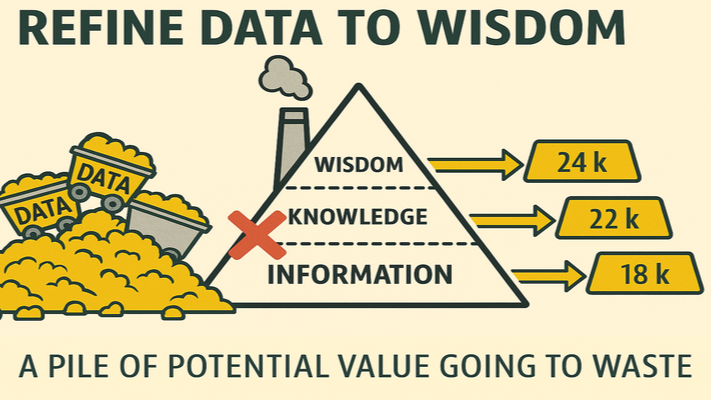
How the absence of shared context blocks the journey from raw data to real value
We don’t suffer from a shortage of data. We suffer from a shortage of shared meaning.
In Article #1 of this series, we explored the idea that data is like raw gold ore: it has potential value, but only becomes truly useful when refined. That refinement process requires structure, interpretation, and above all, context.
But what happens when context doesn’t flow through the organization?
What happens when strategic intent isn’t clearly communicated to those responsible for shaping, processing, and protecting information on the ground?
The answer: meaning gets lost. And with it, the value data could have provided.
Strategy Defines Purpose. Operations Define Reality.
Every organization has high-level ambitions: become customer-centric, ensure sustainability, innovate responsibly, comply continuously. These goals are articulated at the strategy level, sometimes beautifully.
But when these strategic ambitions are translated into projects, processes, systems, and metrics, something often goes missing.
The translation.
Operational teams are asked to act. To deliver. But they aren’t given the contextual map that helps them interpret what those strategic ambitions mean in their domain. Nor are they encouraged to ask for it.
And so, they make assumptions. They guess. They do what seems right. They measure what’s available. And the outcome? Effort without alignment. Action without insight. Gold, wasted.
Meaning Isn’t Trickling Down
Let’s make it real:
- A security team is told to “enable compliance” without being part of the risk discussion.
- A data analyst is asked to “report on performance” without understanding which outcomes matter most to the business.
- A DevOps team is asked to “ensure availability” while unaware of which services are actually critical.
It’s not that these teams don’t want to help. It’s that the why behind the work is disconnected from the how.
When meaning isn’t shared, every team builds its own interpretation. We don’t refine gold. We create 12 different versions of it, none of them pure.
Frameworks Aren’t Bridging the Gap
We already have frameworks. Tons of them.
- TOGAF helps enterprise architects.
- ITIL helps service managers.
- NIST helps security professionals.
- DAMA helps data stewards.
- ISO helps compliance leads.
And that’s the problem.
Each framework works well within its silo. But none of them orchestrate meaning across domains. None of them ensure that what strategy intends is reflected in how operations act.
The result? A security framework that doesn’t inform project delivery. A data model that doesn’t reflect actual business priorities. A service blueprint that aligns with a contract, but not with customer value.
The Real Cost of Misaligned Meaning
When strategy and operations aren’t aligned by a shared interpretive layer:
- We secure things that don’t matter, and leave critical assets exposed.
- We measure what’s easy instead of what’s meaningful.
- We optimize parts instead of improving the whole.
And perhaps most importantly: we make people feel responsible without giving them the context to act responsibly.
That leads to frustration, risk, and missed opportunity.
The Fix? A Shared Language for Meaning
If we want to turn raw data into 24 karat value, we need more than tooling. We need shared interpretation.
That starts by recognizing that context isn’t a nice-to-have — it’s the raw material of alignment.
And it means designing our information processes, our models, our security practices and our decisions around what the data is supposed to mean — to us, in this organization, for these goals.
That’s the missing link. And it’s exactly what we’ll explore in Article #3.

 English | EN
English | EN 